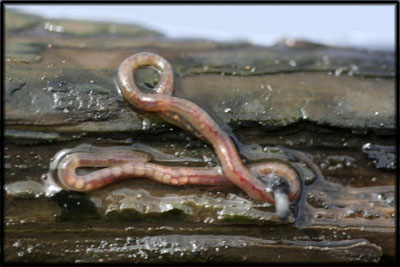
Photography || Portfolio Site || Blog || About || Contact || Home ||
Montana's Un-hatchers
Published in the January/February 2009 issue of the Montana Sporting Journal
By Joshua Bergan
In many cases, winter fishing can be just as productive as summer fishing, and we have a certain class of trout prey to thank for that. Invertebrates known as scuds (or freshwater shrimp), sowbugs, and aquatic annelids (worms) take over as the primary forage food for trout from November and into March, and will catch trout year round. Each is distinct, and each requires a slightly different approach.
Scuds

Scuds range from about 5 to 18 millimeters and are generally a translucent olive-gray color. They are found anywhere there is aquatic vegetation, which includes most fisheries. In some waters, they’re absolutely thick. If you have a seine net, kick up some muck in a weedy area, and run the net through the cloud. The resulting scud storm will give you an idea of why they can be such a big part of a trout’s diet.
To propel themselves, scuds curl up into a ball and expand to full extension.
Oftentimes, you’ll hear pink or orange scuds recommended as fly patterns, but you’ll never see a pink or orange scud swimming around. So why that color? Because they turn pink or orange when they’re dying and dead. These defenseless carcasses become easily identifiable to the trout by their bright color, and trout will key in on that. Naturally, you’ll want to fish pink and orange scuds on a dead drift.
A good time to fish such a pattern on a tailwater is after the water is raised, dropped, and raised again over a short period of time. When the water is raised, the scuds will populate the high water. When the flows drop, they get hung up on rocks that are now exposed. They then die and become this attractive color. When they re-raise the flows, the dead scuds get flushed off the rocks, and become easy meals for tuned-in trout.
Freestone streams like the Big Hole, Bitterroot, Yellowstone, etc., are the least likely to have abundant scud populations (because they don’t generally have as much vegetation) and spring creeks such as Poindexter Slough and Big Spring Creek, are the most likely. Tailwaters like the Beaverhead, Bighorn and Missouri, generally have high populations as well.
When fishing a green scud (which imitates a live scud), an occasional twitch or strip can be helpful.
They are a main forage in most lakes as well, but only effectively fished in the summer (presentation becomes an issue when the lakes are frozen).

Sowbugs
Sowbugs are similar to scuds in appearance. The biggest difference is that they’re usually brown, with worm-like markings on their backs. Another difference is that sowbugs are horizontally flat, while scuds are vertically flat. They’re also a tad bigger, averaging about 1 to 2 centimeters.
The same patterns that will work for scuds, work for sowbugs (albeit in different colors).
A good time to fish a sowbug pattern is after high water flushes them into the current. They’re often tucked away in silty river bottoms, so something needs to dislodge them for sowbugs to become available to trout.
Some anglers have been known to wade through a patch of likely sowbug-holding water, and fish through the aftermath, as the bugs will get kicked up and made available to trout. Doing such a thing is not considered entirely sporting, however.
Aquatic annelids (segmented worms)
If you’ve ever fished the infamous San Juan Worm, you’ve emulated an annelid. They’re not earthworms or night crawlers, rather they’re aquatic worms that are typically smaller and skinnier (much like the San Juan fly).

In all of the aquatic invertebrate investigations I’ve done, I’ve only rarely come across annelids. But based on how effective San Juan Worms are, there must be a ton of them in just about every fishery in the state.
It pays to have San Juan Worms in red, pink, maroon, brown and tan.
They are easy to tie – you just wrap your thread from the eye down to the bend, tie on some ultra chenille, wrap almost back to the eye and tie on the chenille again. To get tapered ends, singe them with a flame. You can add weight by including a bead or copper wire.
Annelid patterns also work well in lakes.
Fishing imitations of all of these creatures will be effective year round, but the trout focus on them in the coldest months because the adult insects are absent (with the exception of midges).
Fisheries known to have large populations of these invertebrates, also generally have huge trout. Where there are a lot of scuds, for example, the fish absolutely gorge themselves, and become downright obese.
Before you wet your line, do a little investigating to see if any of this seafood is present. Success with scuds, sowbugs and San Juans is liable to turn a fair-weather fisher into a four-season angler.